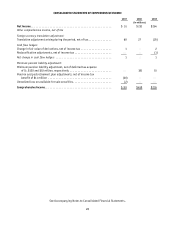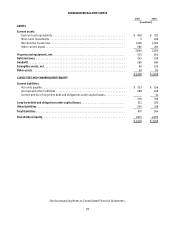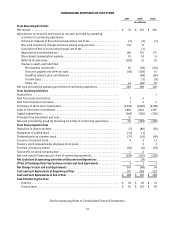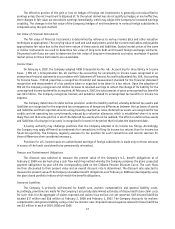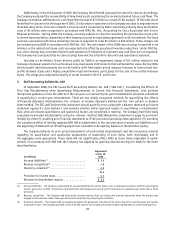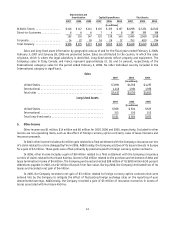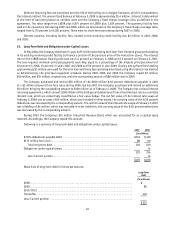Foot Locker 2007 Annual Report Download - page 51
Download and view the complete annual report
Please find page 51 of the 2007 Foot Locker annual report below. You can navigate through the pages in the report by either clicking on the pages listed below, or by using the keyword search tool below to find specific information within the annual report.
35
The following table illustrates the effect on net income and earnings per common share as if the Company had
applied the fair value method to measure stock-based compensation, as required under the disclosure provisions of
SFAS No. 123:
2005
Net income:
As reported. . . . . . . . . . . . . . . . . . . . . . . . . . . . . . . . . . . . . . . . . . . . . . . . . . . . . . . . . . . . $ 264
Compensation expense included in reported net income,
net of income tax benefit . . . . . . . . . . . . . . . . . . . . . . . . . . . . . . . . . . . . . . . . . . . . . . 4
Total compensation expense under fair value method for
all awards, net of income tax benefit . . . . . . . . . . . . . . . . . . . . . . . . . . . . . . . . . . . . . . (9)
Pro forma . . . . . . . . . . . . . . . . . . . . . . . . . . . . . . . . . . . . . . . . . . . . . . . . . . . . . . . . . . . . . $ 259
Basic earnings per share:
As reported. . . . . . . . . . . . . . . . . . . . . . . . . . . . . . . . . . . . . . . . . . . . . . . . . . . . . . . . . . . . $ 1.71
Pro forma . . . . . . . . . . . . . . . . . . . . . . . . . . . . . . . . . . . . . . . . . . . . . . . . . . . . . . . . . . . . . $1.67
Diluted earnings per share:
As reported. . . . . . . . . . . . . . . . . . . . . . . . . . . . . . . . . . . . . . . . . . . . . . . . . . . . . . . . . . . . $1.68
Pro forma . . . . . . . . . . . . . . . . . . . . . . . . . . . . . . . . . . . . . . . . . . . . . . . . . . . . . . . . . . . . . $1.64
Cash and Cash Equivalents
The Company considers all highly liquid investments with original maturities of three months or less, including
commercial paper and money market funds, to be cash equivalents. Amounts due from third party credit card processors
for the settlement of debit and credit cards transactions are included as cash equivalents as they are generally
collected within three business days. Cash equivalents at February 2, 2008 and February 3, 2007 were $472 million and
$208 million, respectively.
Short-Term Investments
The Company accounts for its short-term investments in accordance with SFAS No. 115, “Accounting for Certain
Investments in Debt and Equity Securities.” At February 2, 2008, the Company’s auction rate security was classified
as available-for-sale, and accordingly is reported at fair value. Auction rate securities are perpetual preferred or
long-dated securities whose dividend/coupon resets periodically through a Dutch auction process. A Dutch auction is
a competitive bidding process designed to determine a rate for the next term. As of February 2, 2008, the carrying value
of the Company’s short-term investment of $7 million was reduced by $2 million. The unrealized loss of $2 million was
recorded to accumulated comprehensive loss without tax benefit. There were no unrealized gains or losses recognized
in 2006 and 2005. Realized losses recognized in 2007 were not significant.
Merchandise Inventories and Cost of Sales
Merchandise inventories for the Company’s Athletic Stores are valued at the lower of cost or market using the retail
inventory method. Cost for retail stores is determined on the last-in, first-out (LIFO) basis for domestic inventories and
on the first-in, first-out (FIFO) basis for international inventories. The retail inventory method is commonly used by retail
companies to value inventories at cost and calculate gross margins due to its practicality. Under the retail method, cost
is determined by applying a cost-to-retail percentage across groupings of similar items, known as departments. The cost-
to-retail percentage is applied to ending inventory at its current owned retail valuation to determine the cost of ending
inventory on a department basis. The Company provides reserves based on current selling prices when the inventory
has not been marked down to market. Merchandise inventories of the Direct-to-Customers business are valued at the
lower of cost or market using weighted-average cost, which approximates FIFO. Transportation, distribution center and
sourcing costs are capitalized in merchandise inventories. In 2006, the Company adopted SFAS No. 151, “Inventory
Costs- An Amendment of ARB 43, Chapter 4.” This standard amends the guidance to clarify that abnormal amount of
idle facility expense, freight, handling costs, and wasted materials (spoilage) should be recognized as current-period
charges. With the adoption of this standard the Company no longer capitalized the freight associated with transfers
between its store locations. The Company maintains an accrual for shrinkage based on historical rates.





